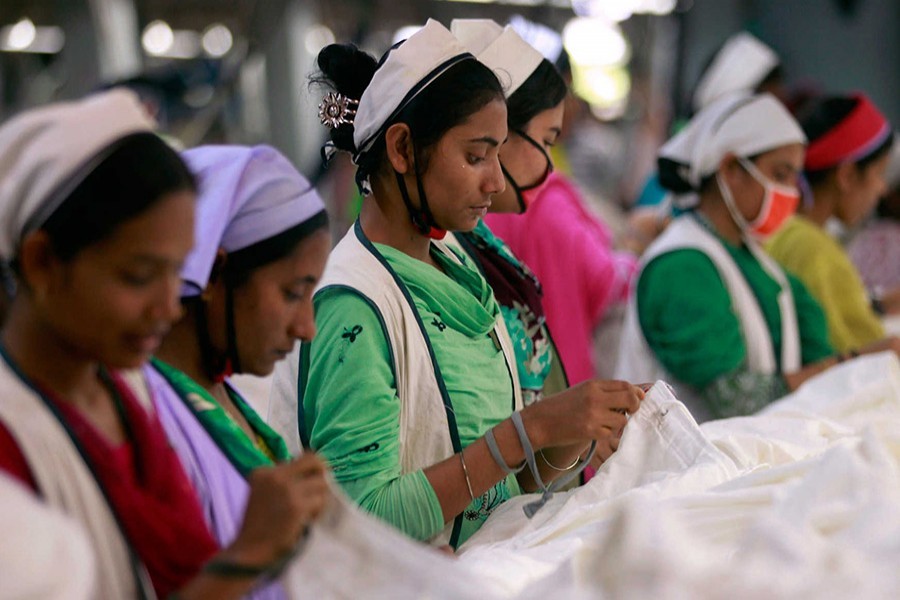The share of proceeds from readymade garment exports in the country's total export earning has gone further up despite exhortations to diversify the country's exportables, said tradespeople.
Knit and woven items contributed 83.22 per cent, or $25.30 billion, of the total export earnings valued at $30.40 billion in the first 10 months of the current fiscal year (FY), according to the latest Export Promotion Bureau (EPB) data.
It was 78.59 per cent in the fiscal year 2011-12.
On the other hand, non-RMG exports have been declining gradually over the years, the data showed.
During the July-April period of the current FY, earnings from all other sectors stood at $5.10 billion, or 16.77 per cent of the total export proceeds.
In FY 2011-12, exports of non-RMG items, including home textile, specialised textile, jute and jute goods, leather and leather goods, pharmaceuticals, plastics, frozen fish and furniture, contributed 21.40 per cent.
Mahmud Hasan Khan, vice-president of Bangladesh Garment Manufacturers and Exporters Association, attributed a number of factors to the growth of the apparel industry.
RMG entrepreneurs are aggressively working to raise their production capacity and expand business. Government policy support also helps the industry flourish further, he added.
Operators in the sector are now manufacturing diversified RMG products, he said, adding that modern machinery have been installed, especially in sweater segment, to add value to relevant products, he added.
Other export-oriented sectors, however, have long been alleging that government's policy support focuses on RMG only.
Md Saiful Islam, president of Leather Goods and Footwear Manufacturers' and Exporters' Association of Bangladesh (LFMEAB), alleged that RMG-focused policy support is one of the key reasons behind the stunted growth of non-RMG sectors.
Bond licence renewal time is three years for RMG, whereas it is two years for leather, he mentioned.
BGMEA can issue utilisation declaration, but LFMEAB cannot issue utilisation permission for leather sector. These are all time-consuming and cumbersome processes, Islam alleged.
He also cited example of EDF [export development fund] and green fund and low-cost housing which are mainly focused on RMG sector.
"Policy support is very important for diversification. Since the RMG sector contributes most they should be given the support. But other sectors also deserve the same attention to help them grow," Mr Islam added.
The government has prioritised export diversification in the 7th five-year plan, but the reality is different because of the discriminatory policy support, he noted.
"We don't need better policy. What we need is the support equivalent to that given to the RMG sector," Mr Islam mentioned.
He said raw material used in the leather sector is not environment-friendly and sought steps for effective functioning of the central effluent treatment plant at Savar Tannery Estate.
He, however, said such dependency on a single sector is not a healthy sign, as any untoward incident happening there might cause a major setback to the national economy.
Echoing Mr Islam of the Bangladesh Jute Mills Association Abdul Barik Khan alleged that all the export-oriented sectors except that of jute get backing from the EDF, though jute millers collect raw materials from local sources while most other sectors import raw materials.
There is no low-cost fund for uplift in the sector to increase capacity and efficiency, he said, adding that the machinery being used in the jute mills are age-old.
When asked, Khondaker Golam Moazzem, additional research director of Centre for Policy Dialogue, said the current growth shows the strength of RMG sector and its internal diversification.
It also shows the weakness of overall dependency on a single sector which is not a positive sign, he added.
Because of such dependency, the government shows weakness and makes misallocation of its limited resources like land, energy and other incentives.
He suggested finding out whether the RMG-based or biased policy support is responsible for a sluggish growth of the non-RMG items.
Garment is the sixth-largest export item in Vietnam which is considered one of the main competitors of Bangladesh, he said, suggesting market demand-based product diversification and measures.


